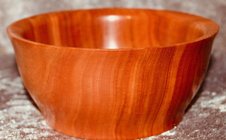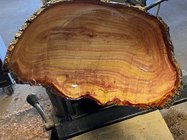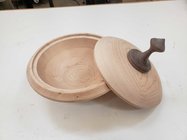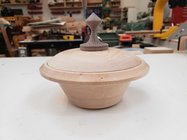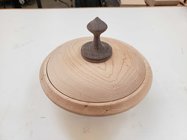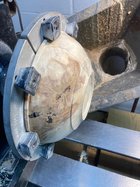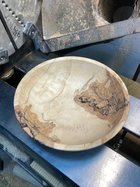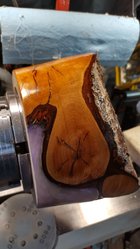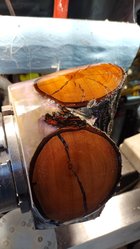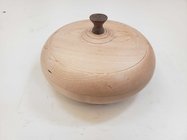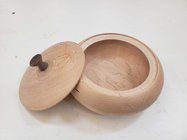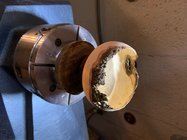I hear those Jimmy Clewes mate hollowers are pretty sweet. (buy one so I won't) lolThat’s my crappy almost dead light that you can see. But this was just caused by a catch. Still learning how to use a Hunter Badger tool, and got a bit light handed (and wrong angled) when I was making one of my final passes. There wasn’t a good way to fix the catch, so I just decided to scrap the bowl. Breaking it apart after was the reward for screwing up. All part of the learning process!
-
November 2025 Turning Challenge: Wall Hanging! (click here for details) -
Congratulations to Craig Morton, People's Choice in the October 2025 Turning Challenge (click here for details) -
Congratulations to Andy Chen for "Mesquite Vase with Polymer Clay Millefiori" being selected as Turning of the Week for November 3, 2025 (click here for details) -
Welcome new registering member. Your username must be your real First and Last name (for example: John Doe). "Screen names" and "handles" are not allowed and your registration will be deleted if you don't use your real name. Also, do not use all caps nor all lower case.
You are using an out of date browser. It may not display this or other websites correctly.
You should upgrade or use an alternative browser.
You should upgrade or use an alternative browser.
What’s on your lathe?
- Thread starter Rusty Nesmith
- Start date
Nice job Michael. I look forward to seeing it when finished... especially the textured interior.More work on the Bradford Bag-o-Sand. Added texture to the exterior, rounded the bottom and reduced the tenon size. Now texturing the interior, which is a painfully slow process. Hopefully worth it!
View attachment 51723
Odie
Panning for Montana gold, with Betsy, the mule!
It's now past 2am, and I'm just now coming in from the shop. Didn't go out there until 7pm, though. This is Red River Gum burl, and it's a first for me. If anyone has experience with RRG, and would like to comment, or give advice.....let me know. This example has gone through my roughing and seasoning process, and a waste block has been attached. Here, I've done nothing more than bring it to round.....it's ready for final shaping and finish turning.....probably will do that tomorrow.
Good night, all.
-----odie-----


Common Name(s): River Red Gum
Scientific Name: Eucalyptus camaldulensis
Distribution: Australia
Tree Size: 100-150 ft (30-46 m) tall, 3-5 ft (1-1.5 m) trunk diameter
Average Dried Weight: 54 lbs/ft3 (870 kg/m3)
Specific Gravity (Basic, 12% MC): .67, .87
Janka Hardness: 2,160 lbf (9,600 N)
Modulus of Rupture: 17,940 lbf/in2 (123.8 MPa)
Elastic Modulus: 1,711,000 lbf/in2 (11.80 GPa)
Crushing Strength: 8,370 lbf/in2 (57.8 MPa)
Shrinkage: Radial: 5.3%, Tangential: 8.8%, Volumetric: 14.1%, T/R Ratio: 1.7
Good night, all.
-----odie-----


Common Name(s): River Red Gum
Scientific Name: Eucalyptus camaldulensis
Distribution: Australia
Tree Size: 100-150 ft (30-46 m) tall, 3-5 ft (1-1.5 m) trunk diameter
Average Dried Weight: 54 lbs/ft3 (870 kg/m3)
Specific Gravity (Basic, 12% MC): .67, .87
Janka Hardness: 2,160 lbf (9,600 N)
Modulus of Rupture: 17,940 lbf/in2 (123.8 MPa)
Elastic Modulus: 1,711,000 lbf/in2 (11.80 GPa)
Crushing Strength: 8,370 lbf/in2 (57.8 MPa)
Shrinkage: Radial: 5.3%, Tangential: 8.8%, Volumetric: 14.1%, T/R Ratio: 1.7
Hard to take all the same would have looked good. In reply to Michael Anderson.
I turned a small 1/4 sawn sample (5x3) of RRG a while back. It was pretty easy turning wood and dried with little movement. Most memorable was the smell. It reminded me of Elmer's paste that we used in grade school.It's now past 2am, and I'm just now coming in from the shop. Didn't go out there until 7pm, though. This is Red River Gum burl, and it's a first for me. If anyone has experience with RRG, and would like to comment, or give advice.....let me know. This example has gone through my roughing and seasoning process, and a waste block has been attached. Here, I've done nothing more than bring it to round.....it's ready for final shaping and finish turning.....probably will do that tomorrow.
Good night, all.
-----odie-----
View attachment 51792 View attachment 51793
Common Name(s): River Red Gum
Scientific Name: Eucalyptus camaldulensis
Distribution: Australia
Tree Size: 100-150 ft (30-46 m) tall, 3-5 ft (1-1.5 m) trunk diameter
Average Dried Weight: 54 lbs/ft3 (870 kg/m3)
Specific Gravity (Basic, 12% MC): .67, .87
Janka Hardness: 2,160 lbf (9,600 N)
Modulus of Rupture: 17,940 lbf/in2 (123.8 MPa)
Elastic Modulus: 1,711,000 lbf/in2 (11.80 GPa)
Crushing Strength: 8,370 lbf/in2 (57.8 MPa)
Shrinkage: Radial: 5.3%, Tangential: 8.8%, Volumetric: 14.1%, T/R Ratio: 1.7
Attachments
Hi Odie- Is that Watco Danish oil, which you mentioned you use? If you could tell me a bit about your application process I would appreciate it. I want to give Watco a try.Finished a small Marblewood bowl last night.
Workability: Tends to be difficult to work on account of its high density. Marblewood can have a moderate to severe blunting effect on tool cutters. Glues, turns, and finishes well—though there is a high risk of checking and resin exudation during drying.
Comments: The high contrast between the golden body and the much darker streaks give it an appearance somewhat similar to natural marble, hence the common name of “Marblewood” for this species. Marblewood’s overall appearance is very similar to Zebrawood, though Marblewood tends to have a slightly finer texture.
Common Name(s): Marblewood, Angelim Rajado
Scientific Name: Zygia racemosa (syn. Marmaroxylon racemosum)
Distribution: Northeastern South America
Tree Size: 65-100 ft (20-30 m) tall, 1-2 ft (.3-.6 m) trunk diameter
Average Dried Weight: 63 lbs/ft3 (1,005 kg/m3)
Specific Gravity (Basic, 12% MC): .77, 1.00
Janka Hardness: 2,530 lbf (11,250 N)
-----odie-----
View attachment 51386 View attachment 51387
Odie
Panning for Montana gold, with Betsy, the mule!
Hi Will......Hi Odie- Is that Watco Danish oil, which you mentioned you use? If you could tell me a bit about your application process I would appreciate it. I want to give Watco a try.
Here is an explanation of my method here in the comment section of this bowl:

2109 Maple Burl.
Completed 9/9/2022, original block was 16% MC, and after roughing without anchorseal, it took a total of 4 months to stabilize. 7 1/2" x 2 3/8", 8.3 oz, sanded to 600gt, Danish oil natural, Beall 3-step buffed. -----odie-----
I've found that I'm being asked this question often.....good luck to you, Will...... It is a matter of wood prep for the buffing that matters in getting a good finish with Danish oil.
If you run searches for my application methods of Danish oil, you'll fine that over the years, my methods have evolved......but, the link I gave you is my latest response to this question.
-----odie-----
Last edited:
Outstanding!latest piece. Plum log i did a wood swap with from a fellow turner in Illinois . Walnut oil finish
My first lidded box. Birdseye maple with a walnut finial. I think the finial could have been a bit more delicate. I like the way the overall shape turned out - a bit different I think than the normal ovoid shapes. The body of the box was glued up from three pieces of stock as I didn't have any really thick birdseye maple, so the glue lines are somewhat apparent. Next time I'll try to hide or disguise them in the shape. On to the next project.
Attachments
Great! Thanks Odie!Hi Will......
Here is an explanation of my method here in the comment section of this bowl:

2109 Maple Burl.
Completed 9/9/2022, original block was 16% MC, and after roughing without anchorseal, it took a total of 4 months to stabilize. 7 1/2" x 2 3/8", 8.3 oz, sanded to 600gt, Danish oil natural, Beall 3-step buffed. -----odie-----www.aawforum.org
I've found that I'm being asked this question often.....good luck to you, Will...... It is a matter of wood prep for the buffing that matters in getting a good finish with Danish oil.
If you run searches for my application methods of Danish oil, you'll fine that over the years, my methods have evolved......but, the link I gave you is my latest response to this question.
-----odie-----
The purple does stay as a darker rich color but thankfully the slime green disappears.Another piece of black walnut with some nice grain. Calabash meets bag of sand form. Don’t you wish the greens and purples stuck around?
View attachment 51840
I hope you are going to do the inside before it starts drying.
I kind of wished the slime green stuck around. Well, for certain pieces! And yes, definitely hogged out the interior right after this photo.I hope you are going to do the inside before it starts drying.
"Bag of sand form"..... Cracked me up! It does work though...
robo hippy
robo hippy
Once I heard someone call it that, I can't think of anything else haha"Bag of sand form"..... Cracked me up! It does work though...
robo hippy
Quaking Aspen burl. Roughed out last year and finish turned today, couldn't believe how hard the wood was when dried. Had to hone the gouge every cut to get a good finish. About 8 1/2" diameter x 3" total height.
Attachments
Turning hybrid epoxy and plum? Or apricot. For a friend/family. Lots of epoxy cleanup before the next pour. Have a consult on whether live edge or epoxy voids. I'm hopping for a good balance.
Attachments
Odie
Panning for Montana gold, with Betsy, the mule!
Coming in late again this evening. Here is a follow-up to the Red River Gum bowl I posted a couple days ago. I wasn't feeling well yesterday, so there was no time spent in the shop.....feeling better today, though. Didn't go out there until 9pm, but still was good for a 5-hour shop session tonight!It's now past 2am, and I'm just now coming in from the shop. Didn't go out there until 7pm, though. This is Red River Gum burl, and it's a first for me. If anyone has experience with RRG, and would like to comment, or give advice.....let me know. This example has gone through my roughing and seasoning process, and a waste block has been attached. Here, I've done nothing more than bring it to round.....it's ready for final shaping and finish turning.....probably will do that tomorrow.
Good night, all.
-----odie-----
View attachment 51792 View attachment 51793
I turned a small 1/4 sawn sample (5x3) of RRG a while back. It was pretty easy turning wood and dried with little movement. Most memorable was the smell. It reminded me of Elmer's paste that we used in grade school.
Howdy Monty......not sure if our examples of RRG are comparable, but I found this piece to be very hard and dense. In spite of that, I also found it to be fairly easy to turn, with little movement in the seasoning process. I didn't detect any distinct smell to my piece, but I wasn't paying much attention to that anyway.
-----odie-----


Note: That black dot above the inventory number on the waste block, originally lined up with the hole in the screw center chuck. If I have a catch, the bowl will tighten on the screw, and I check to see if there is a resulting alignment issue with the bowl to chuck. There were no catches with this bowl, so the only other thing that can account for the bowl tightening on the screw, is if I hog off too much wood at a time.....that would sometimes, but not always result in the bowl tightening on the screw. Regardless, I try not to do anything that would make the bowl tighten on the screw, and I didn't encounter any issues resulting from that.....so, all is good!
-o-
Last edited:
This is Red River Gum burl, and it's a first for me. If anyone has experience with RRG, and would like to comment, or give advice.....let me know.
We tend to call it River Red Gum down this way to distinguish it from Forest Red Gum.
I've turned a considerable amount of it over the years from my stockpile that was put aside almost 50 years ago, some of which was from cattleyard fenceposts that had stood for a 100 years before that. The wood that has been seasoning that long becomes darker. The older the living tree was the more likely it will have cranky and interesting wood grain. Mature specimens live for 500 to 1,000yrs...
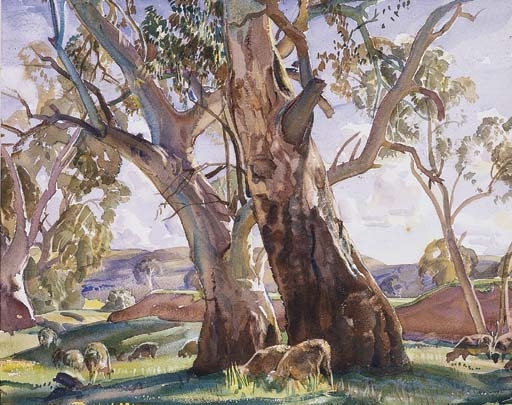
A few RRG pieces, the older wood on the right...
As you can see, my preference is to leave the RRG pieces as simple as possible to allow the wood to talk for itself.
I can't think of anything in particular to say about how it turns. The old cattle yard fenceposts are usually full of abrasive grit, but that is unlikely to be an issue with your piece Odie.
Odie
Panning for Montana gold, with Betsy, the mule!
We tend to call it River Red Gum down this way to distinguish it from Forest Red Gum.
I've turned a considerable amount of it over the years from my stockpile that was put aside almost 50 years ago, some of which was from cattleyard fenceposts that had stood for a 100 years before that. The wood that has been seasoning that long becomes darker. The older the living tree was the more likely it will have cranky and interesting wood grain. Mature specimens live for 500 to 1,000yrs...

A few RRG pieces, the older wood on the right...
As you can see, my preference is to leave the RRG pieces as simple as possible to allow the wood to talk for itself.
I can't think of anything in particular to say about how it turns. The old cattle yard fenceposts are usually full of abrasive grit, but that is unlikely to be an issue with your piece Odie.
Thank you for your response, Neil......
BTW: That's a fabulous watercolor painting with a difficult subject......yours? I've always been intrigued, and a great admirer of good watercolor, and it's related great brushwork. The artist doesn't get any second chances if he(she) screws up!
I enjoyed that as much as seeing your excellent examples of RRG bowls.
BTWx2: Even though I have never visited the land down under, I have a special regard for you Aussies. I served side by side with pilots and men of the Royal Australian Navy during the Vietnam war 1968-69. Matter of fact, my own aircraft commander (AC) was a lieutenant (same as captain in the army) and my flight platoon leader.....and a man, to this day, I have the highest respect for. I served on his flight crew as Crew Chief and right door gunner.....and, I might not be here at all, if it weren't for this man! This experience gave me a special appreciation for the mettle, common to the men who represent your country in battle.
-----odie-----
Last edited:
Lidded box V2.0. A more typical shape for such vessels, I think. Body is a bit thicker than I wanted - my undercutting technique on the inside needs work - but the lid and finial turned out OK. Birdseye maple and walnut.
Attachments
Do you use the faceplate ring with your axminster or the wood screw puck when you initially mount the blank? I was wondering what screws you use if faceplate ring.Roughing out some calabashes. Here is a Black Walnut one that should be really nice whenever I get back to finish turning it:
View attachment 51801
Red River Gum is quite common and readily turned, with great age comes brittleness and hardness and its one of those ' its what it is' situations By Australian standards its not very hard, but rather stiff. Stiff as in it leave a good finish if you have a good edge, bearing mind it often has grit, dirt, rock and sand in and on it due to its age. But at the end of the day I like it and enjoy turning it even when it argues some as it will give you a great finish for those who persevere.Thank you for your response, Neil......
BTW: That's a fabulous watercolor painting with a difficult subject......yours? I've always been intrigued, and a great admirer of good watercolor, and it's related great brushwork. The artist doesn't get any second chances if he(she) screws up!
I enjoyed that as much as seeing your excellent examples of RRG bowls.
BTWx2: Even though I have never visited the land down under, I have a special regard for you Aussies. I served side by side with pilots and men of the Royal Australian Navy during the Vietnam war 1968-69. Matter of fact, my own aircraft commander (AC) was a lieutenant (same as captain in the army) and my flight platoon leader.....and a man, to this day, I have the highest respect for. I served on his flight crew as Crew Chief and right door gunner.....and, I might not be here at all, if it weren't for this man! This experience gave me a special appreciation for the mettle, common to the men who represent your country in battle.
-----odie-----
I would say Odie your forms are well suited to the RRG and RG as thin cross-sections and fine edges are readily damaged due to hardness it's brittle nature.
Thank you for your response, Neil......
BTW: That's a fabulous watercolor painting with a difficult subject......yours? I've always been intrigued, and a great admirer of good watercolor, and it's related great brushwork. The artist doesn't get any second chances if he(she) screws up!
No Odie, not my watercolour painting, unfortunately! Watercolour was probably my least successful subject at art school.
That painting was done by Sir Hans Heysen who is probably one of Australia's best landscape painters who is best known for his paintings of gum tree scenes like that. He lived and had his studio near to me at Hahndorf in the Adelaide Hills among the red gums where many of his paintings were done. I sell my work through a gallery in Hahndorf and it is no surprise that my redgum pieces always sell well there!
Looks like the woodpeckers are alive and well in your neighborhood.Ash from neighbor’s treeView attachment 51899
We do have a healthy population of woodpeckers but those holes are bugs of various sorts. The tree was an Arizona Ash about 60 years old and declining when we had hard freezes (for central TX) the last couple of years so it was essentially standing dead when it was taken down.Looks like the woodpeckers are alive and well in your neighborhood.
Black and White Ebony shaving brush. 600-grit,Triple E friction polish, and starting to burnish in light coats of thinned TruOil on the lathe at speed. It might take 3 or 4. I started turning so that I could turn shaving brushes to match my straight razors. I've got 6 more in different woods to do for a group of teacher friends, the finest men I know. Held in my Beall Collet Chuck with the 3/4" collet and about a 3/4"-inch long tenon.


Attachments
Last edited:
Hey Sam. I’ve only used the faceplate ring once. I use #10 sheet metal screws. They run a little bit proud of the faceplate ring holes, and sort of interfere with how it sits in the Chuck. Smaller screws would work perfectly. I prefer to just use regular faceplates for that anyway, as they vibrate less. I have used the screw Chuck insert many times though. The only problem with that is the screw has a tendency to come loose during roughing. Not a huge deal though, as it’s fast to tighten.Do you use the faceplate ring with your axminster or the wood screw puck when you initially mount the blank? I was wondering what screws you use if faceplate ring.
Last edited:
I run across a brand that the heads all snapped off trying to remove them even before turning with green wood.Hey Sam. I’ve only used the faceplate ring once. I use #10 sheet metal screws. They run a little bit proud of the faceplate ring holes, and sort of interfere with how it sits in the Chuck. Smaller screws would work perfectly. I prefer to just use regular faceplates for that anyway, as they vibrate less. I have used the screw Chuck insert many times though. The only problem with that is the screw has a tendency to come loose during roughing. Not a huge deal though, as it’s fast to tighten.
#10 stainless flat head sheet metal is what I use too. I thought the #12 stuck up too far.
Grip fast brand I believe is what I have the best luck with but I only find them with phillips head at the local store and I'd like to find a good brand with a square drive.
That screw loosened in my insert too but it must have enough dust built up or something because it hasn't come loose the last couple of times.
Look for some Hillman 12x1 1/4. I get them at Ace Hardware locally. I've never had one of these break or strip the head as long as I used the right size bit.I run across a brand that the heads all snapped off trying to remove them even before turning with green wood.
#10 stainless flat head sheet metal is what I use too. I thought the #12 stuck up too far.
Grip fast brand I believe is what I have the best luck with but I only find them with phillips head at the local store and I'd like to find a good brand with a square drive.
That screw loosened in my insert too but it must have enough dust built up or something because it hasn't come loose the last couple of times.
Here is the finished Redbud burl piece that I posted about earlier in this thread. It’s sort of a proof of concept for a project that is still swimming in my head. That said, I think it’s a better fit here than the actual Gallery (even though it’s no longer on my lathe lol). The base is a piece of Mesquite with the bottom section left natural.


Russ Braun
TOTW Team
Makes me wonder how a bent wire (as opposed to straight) would look on this piece. It might add some greater flow to the piece! Perhaps this piece could use some ED (or Peyronie‘s Disease), lol!!Here is the finished Redbud burl piece that I posted about earlier in this thread. It’s sort of a proof of concept for a project that is still swimming in my head. That said, I think it’s a better fit here than the actual Gallery (even though it’s no longer on my lathe lol). The base is a piece of Mesquite with the bottom section left natural.
View attachment 51924

